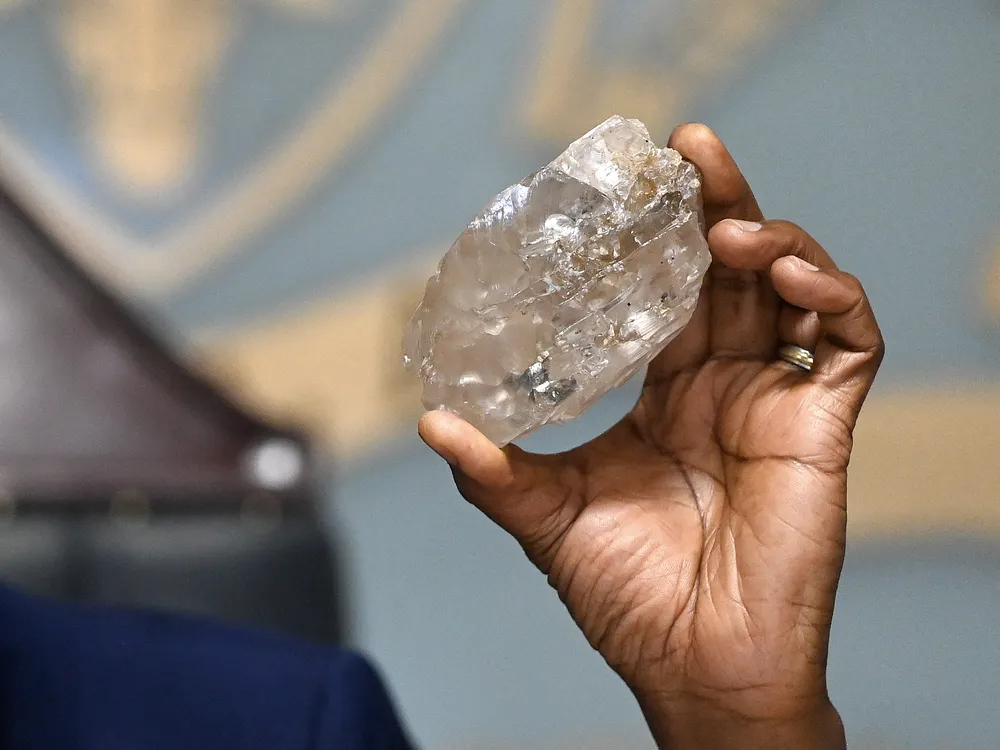Largest Diamond Since 1905 Unearthed by Miners in Botswana
Volcanic eruptions long ago brought the 2,492-carat diamond—the latest in a string of stunning discoveries over the last decade—to the surface

Miners in Botswana made a dazzling discovery this week, when they uncovered a 2,492-carat diamond, weighing about one pound. The last time miners unearthed a diamond this big, the Model T Ford was still three years away from rolling off the assembly line.
“This is history in the making,” Naseem Lahri, Botswana managing director for Lucara Diamond Corp., the Canadian mining company that found the gem, tells Sello Motseta of the Associated Press (AP). “I am very proud. It is a product of Botswana.”
The new diamond was excavated at the Karowe mine, about 300 miles north of Botswana’s capital city of Gaborone. The same mine has produced four other large rough diamonds in the last decade, including the 813-carat Constellation diamond that sold for a record $63 million in 2016.
This week’s find is almost the largest diamond uncovered by miners in history, second only to the 3,106-carat Cullinan diamond found in South Africa in 1905. That gem was cut into stones and put into the English Crown Jewels. An even bigger, black diamond was found in Brazil in the late 1800s, but experts think that one came from a meteorite.
Diamonds in Botswana are found in volcanic features called kimberlite pipes. These carrot-shaped structures brought rocks that formed deep within Earth’s mantle up to the surface during volcanic eruptions long ago. The heat and pressure that rocks experience at profound depths, between 93 and 280 miles underground, are critical to forming diamonds.
Powerful eruptions, propelled by the expansion of volatile molecules like carbon dioxide, send magma rushing upward. The fiery material breaks off fragments of diamond-bearing rock and transfers them to the surface. Kimberlites likely develop after the breakup of supercontinents, as the Earth’s mantle churns following the catastrophic rifting, according to a 2023 study.
Kimblerlite pipes are rare, and only about one percent of the deposits bear quality diamonds. At the Karowe mine, the diamonds formed deep within the mantle billions of years ago, and they erupted to the surface about 90 million years ago.
“All of the stars aligned with that volcanic eruption, and the conditions were just perfect,” Paul Zimnisky, an independent analyst in the diamond industry, tells the New York Times’ Lynsey Chutel.

On Thursday, President Mokgweetsi Masisi of Botswana became one of the first people to look at the newly discovered diamond up-close. It was large enough to fill up the palm of his hand.
“It is overwhelming,” he said, per the AP. “I am lucky to have seen it in my time.”
Botswana is the world’s second-largest producer of diamonds, responsible for about 20 percent of the global output.
Finding large diamonds has become more common in recent years as a result of technological developments. Companies use advanced X-ray devices to locate big diamonds in the ore, and refined grinding techniques help avoid breaking them into small pieces during the process of removing the gems from their host rocks.
Lucara aims to leverage these developments with a lofty goal in mind: finding the largest diamond ever.
William Lamb, the company’s chief executive, tells the New York Times, “We believe that we can eclipse the Cullinan.”